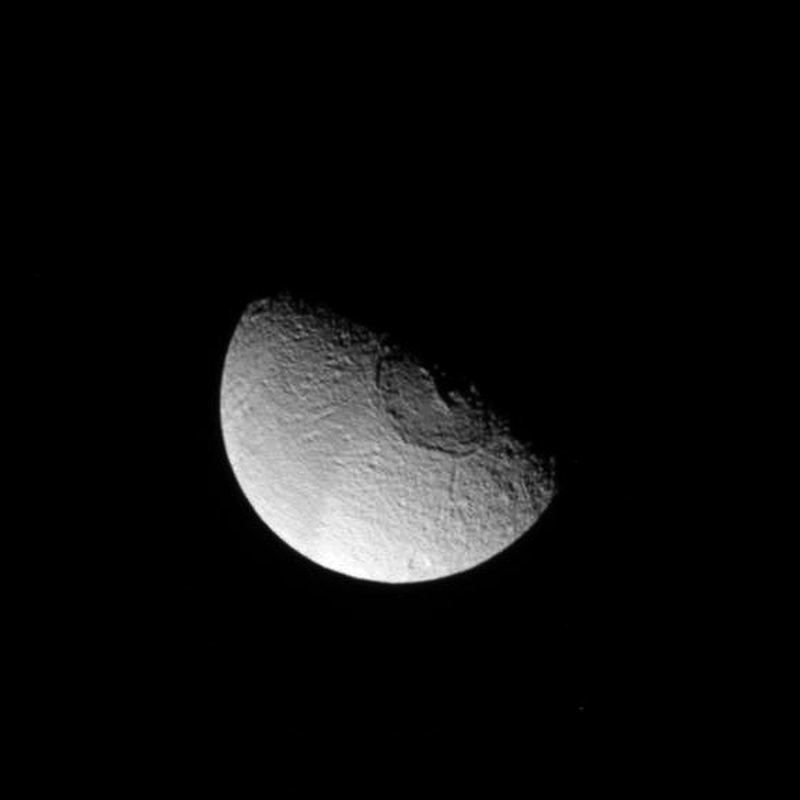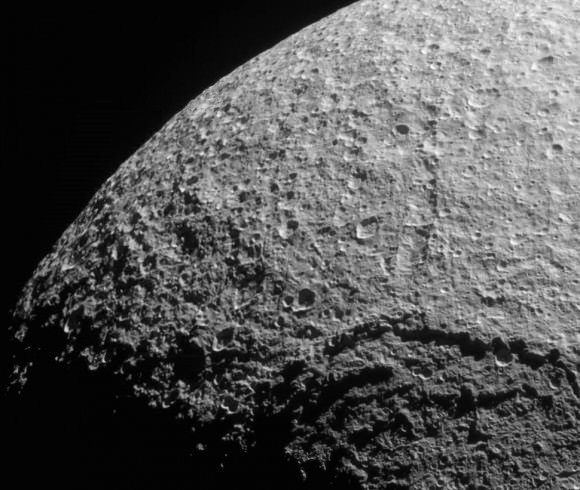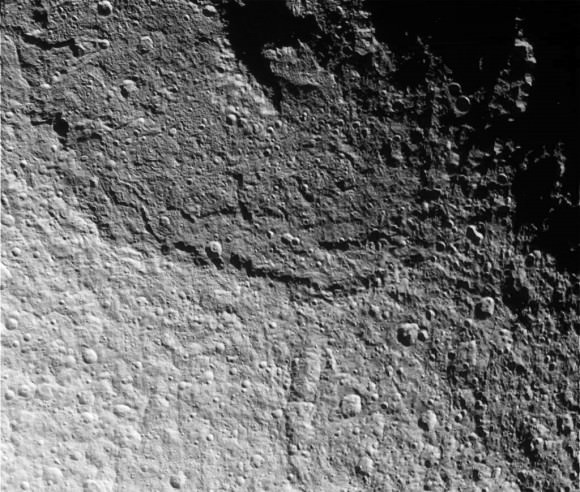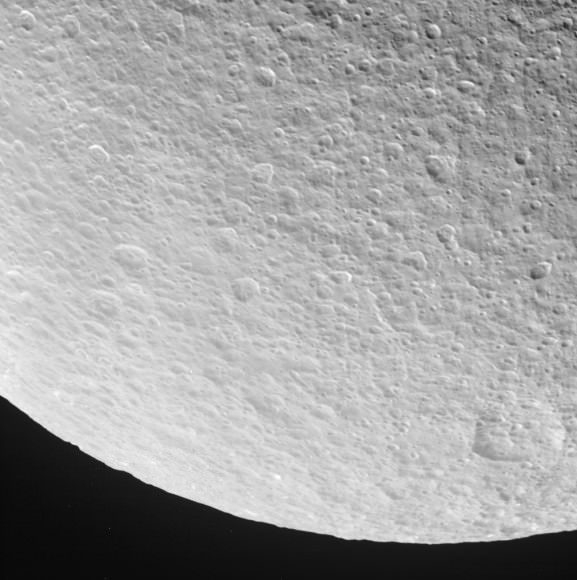On June 28 NASA’s Cassini spacecraft passed by Tethys, a 1,062-kilometer (662-mile) -wide moon of Saturn that’s made almost entirely of ice. Tethys is covered in craters of all sizes but by far the most dramatic of all is the enormous Odysseus crater, which spans an impressive 450 kilometers (280 miles) of the moon’s northern hemisphere — nearly two-fifths of its entire diameter!
In fact, whatever struck Tethys in the distant past probably should have shattered it into pieces… but didn’t.
Tethys likely held itself together because when the impact occurred that formed Odysseus, the moon was still partially molten. It was able to absorb some of the energy of the impact and thus avoid disintegration — although it was left with a quite the battle scar as an eternal reminder.
The images below are raw images from Cassini’s latest pass of Tethys, showing the moon’s rugged terrain and portions of Odysseus from a distance of 68,521 kilometers (42,577 miles).
The central peak of Odysseus has collapsed, leaving a depression — another indication that the moon wasn’t entirely solid at the time of impact.
Tethys orbits Saturn at a distance of 294,660 kilometers (183,100 miles), about 62,000 miles closer than the Moon is from Earth. Such a close proximity to Saturn subjects Tethys to tidal forces, the frictional heating of which likely helped keep it from cooling and solidifying longer than more distant moons. As a result Tethys appears somewhat less cratered than sister moons Rhea and Dione, which still bear the marks of their earliest impacts… although looking at the region south of Odysseus it’s hard to image a more extensively-cratered place.
Tethys is just another reminder of the violent place our solar system can be. Find out more about Tethys on the Cassini mission site here.
Image credits: NASA/JPL/Space Science Institute. Edited by J. Major. Images have not been calibrated or validated, and each has been level-adjusted and sharpened to bring out surface detail, and in some areas deinterlacing was used to remove linear raw image artifacts.





ahem…. ”
nearly two-fifths of its entire surface”?
2/5?
Math fail, and sanity check fail – just look at the picture…
Apologies… “diameter”, not “surface”.
Ah, a typing fail then. Much less severe. 🙂
Happy fourth! There must have been some serious fireworks when that crater formed.
Which leaves you thinking – if the moon is made almost entirely out of ice, and that sort of impact sure caused the ice to melt/boil/sublimate – how come the crater looks so much like a “rocky” crater? (At least to my very untrained eye)
Probably because (water) ice at extremely cold temperatures, in that region of the Solar System, is as hard as steel.
Precisely. It’s around -300ºF out there, and water is as hard – or harder – than rock is here.
Turns out Wiki’s got us covered, on both the moon and the crater.
Water is not going to be as hard as steel, even while cold… Steel is pretty hard. However, behavior of material under impact is very misleading… Things that penetrate concrete, for example, break up on hitting water. If anything, a more brittle-behaving moon might lose more material on impact, since a softer (kinder?) moon can absorb more of the impact energy.
Er… I think that the boys at Harvard will give you an argument:
“[…] Titan’s surface temperature is a frigid ~75 K (-200°C)—so cold that ordinary ice would be as hard as steel and even methane lakes frozen.”* (Emphasis mine.)
*Source: Harvard Education – Cosmic Evolution (see last paragraph).
Huh. “hard as steel” can be interpreted in many ways… And this reference is not exactly trying to be precise in terms of material science….
I looked up the phase diagram of water at cryogenic temperatures, like here: https://256.makerslocal.org/wiki/DIY_Freeze_Dryer and there is a phase transition near -200C, so possibly the ice there is in phase XI… which might be harder, but:
– we should define which of the many definitions of “hard” we’re talking about
– we should get the data for water
– we should get the precise data for the environment on that moon
– we should get the data for steel
or, we should go out and clean the BBQ.
If your BBQ is made of steel, it will become very brittle at extremely cold temperatures.
I too get brittle at cold temperatures, and so avoid winter BBQ for fear of thermal shock
I’ll wager that whatever hit it may have been large, but not particularly massive. Maybe a comet that had long since lost most of its ice from visits to the sun. Maybe an empty honeycomb of rock that hit hard but didn’t have as much momentum as a solid iron asteroid.
You guys should really come to a consensus in using either km first and miles second or the other way around. I see articles where they are all scrambled up.
“Tethys orbits Saturn at a distance of 294,660 kilometers (183,100 miles), about 62,000 miles closer than the Moon is from Earth.”
If you described the distance in km and put miles into brackets why not keep the same idea also in the second part of the sentence?
I don’t get how Tethys is ”
made almost entirely of ice” but then it goes on to say ”
the moon was still partially molten.”???
How does ice/water/steam be partially molten in space? Maybe I’m a layman so if anyone can explain I would appreciate it.
Mike. 🙂
Not really explain, no. Water can form an ice sludge, and the small rocky core they talk of can have started out as a melt. If it had cooled for a while, I presume an ice cap + sludge + water + heated core would be present.
What they really talk about is elasticity:
“That diameter is nearly two-fifths of Tethys itself. Such an impact
could have shattered a solid body, which suggests that the internal
composition of Tethys was still partially molten. The crater’s rim and
central peak have largely collapsed, leaving a shallow crater, and this
also suggests a terrain that was elastic enough to change shape. The
subdued features of Odysseus are in contrast to many steep cliffs
elsewhere. This again suggests that the ancient terrain that was still
elastic enough to change shape.”
An ice cap that is sufficiently thick, and Tethys is ~ 500 km in radius, could be convecting the heat out by slow ice flows instead of conducting the heat as a thin ice layer would do. (Think glacier, not lake.) It is then elastic and changing shape. So maybe whatever hit, hit at a most opportune moment, not shattering the moon but still preserving most of the impact scar.
Well, that is one hypothesis.
The object which caused this crater was probably another mini-moon in an orbit around Saturn. The impact might then have been rather gentle with small relative velocity between two objects, Tethys and the other mini-moon; neither of which were terribly dense.
LC
Hmmm, impressive, yes. But I dont know if it can match the shear awesome spectical of the teenager’s cratered faces working at the Taco Bell downtown.
Fear not. One day that teenager will be your CEO, and you will be his bitch.